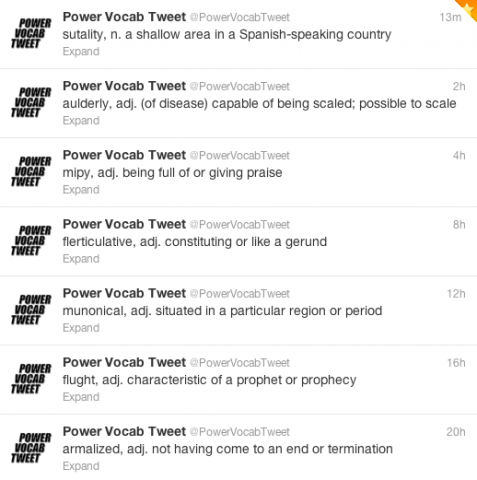
Power Vocab Tweet is a twitter bot written by Allison Parish, which posts randomly generated words and their markov’d definitions. She calls this an exploration into “speculative lexicography”. I found this work interesting because it takes a generative approach to text (a lot of high profile examples of generative media are based in art and sound), and because it attempts to kind of assault readers with randomness; by compelling an audience to process this random, generated text, it forces them to think about something truly novel and reflect – in the same way Dada often does.
Parish explains that the project was inspired by the many existing “word of the day” twitter bots that send users new vocabulary words daily. She also draws philosophical inspiration from author Suzette Haden Elgin. Parish explains:
“Elgin’s contention is that the manner in which a language “chunks” the universe of human perception into words reflects and reinforces structures of power; therefore, to break the world up into words differently is a means of counteracting the status quo.”
In her work (albeit less rigorously), Parish attempts to explore similar themes.
I like the artist’s idea of making their audience think by having them read plausible but ultimately meaningless text. However, I’m not sure if I believe this project manages to do that. I think there exists a lot of content that compels us to reflect and emote, but vocab words and their definitions aren’t one of them, if not simply because there are so many words out there we simply do not know or never use – it’s neither a novel nor a particularly gripping experience. I would rather she do generative “missing child” signs or history books, something where imbibing the text triggers an emotion or forces us to buy into the nonsense on the page.
Energy Flow, a joint effort of FIELD and The Creator’s project, is an interactive, generative film that links together 4-10 storylines about the forces that shape the modern world – the narrative changes each time the film is played. It employs non-linear narrative and abstract representation, entreating the viewer to bring their own interpretation to what they see on the screen.
This project excites me because it uses generative narrative to try and make compelling statements about the world at large. I haven’t seen the film, but the medium of generative filmmaking is very interesting to me, and it appears that the creators created complex algorithms to power the presentation.
The statement that the responsibility of creating a message from the content lies on the viewer is a little sketchy – an argument could be made that even with randomness, the creator should have some intent or meaning in mind, and that if it isn’t communicated, the nonlinear medium is sort of ineffective. I don’t know how much I buy into that, though.
The piece is inspired by “current” events such as Arab Spring and Fukishima – the piece tries to address the chaos of the modern day. Many of FIELD’s previous projects also explored generative form and nonlinear narrative.